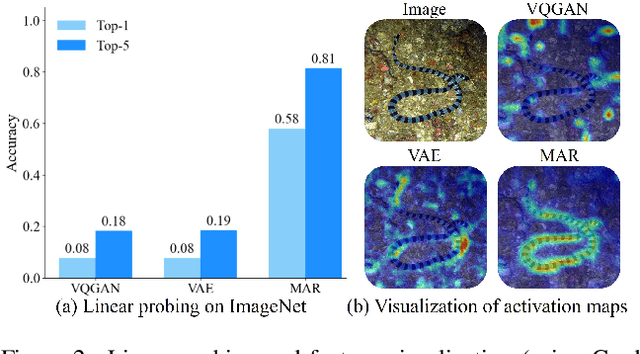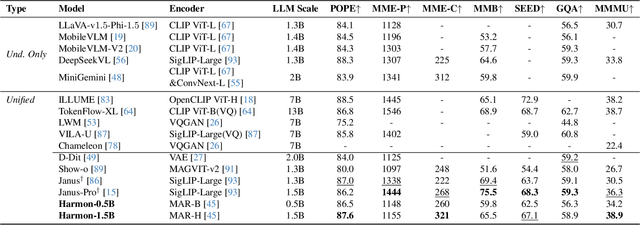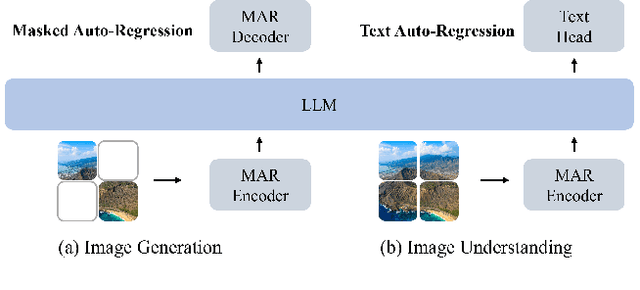Size Wu
OpenUni: A Simple Baseline for Unified Multimodal Understanding and Generation
May 29, 2025Abstract:In this report, we present OpenUni, a simple, lightweight, and fully open-source baseline for unifying multimodal understanding and generation. Inspired by prevailing practices in unified model learning, we adopt an efficient training strategy that minimizes the training complexity and overhead by bridging the off-the-shelf multimodal large language models (LLMs) and diffusion models through a set of learnable queries and a light-weight transformer-based connector. With a minimalist choice of architecture, we demonstrate that OpenUni can: 1) generate high-quality and instruction-aligned images, and 2) achieve exceptional performance on standard benchmarks such as GenEval, DPG- Bench, and WISE, with only 1.1B and 3.1B activated parameters. To support open research and community advancement, we release all model weights, training code, and our curated training datasets (including 23M image-text pairs) at https://github.com/wusize/OpenUni.
Harmonizing Visual Representations for Unified Multimodal Understanding and Generation
Mar 27, 2025



Abstract:Unifying visual understanding and generation within a single multimodal framework remains a significant challenge, as the two inherently heterogeneous tasks require representations at different levels of granularity. Current approaches that utilize vector quantization (VQ) or variational autoencoders (VAE) for unified visual representation prioritize intrinsic imagery features over semantics, compromising understanding performance. In this work, we take inspiration from masked image modelling (MIM) that learns rich semantics via a mask-and-reconstruct pre-training and its successful extension to masked autoregressive (MAR) image generation. A preliminary study on the MAR encoder's representation reveals exceptional linear probing accuracy and precise feature response to visual concepts, which indicates MAR's potential for visual understanding tasks beyond its original generation role. Based on these insights, we present \emph{Harmon}, a unified autoregressive framework that harmonizes understanding and generation tasks with a shared MAR encoder. Through a three-stage training procedure that progressively optimizes understanding and generation capabilities, Harmon achieves state-of-the-art image generation results on the GenEval, MJHQ30K and WISE benchmarks while matching the performance of methods with dedicated semantic encoders (e.g., Janus) on image understanding benchmarks. Our code and models will be available at https://github.com/wusize/Harmon.
F-LMM: Grounding Frozen Large Multimodal Models
Jun 09, 2024



Abstract:Endowing Large Multimodal Models (LMMs) with visual grounding capability can significantly enhance AIs' understanding of the visual world and their interaction with humans. However, existing methods typically fine-tune the parameters of LMMs to learn additional segmentation tokens and overfit grounding and segmentation datasets. Such a design would inevitably cause a catastrophic diminution in the indispensable conversational capability of general AI assistants. In this paper, we comprehensively evaluate state-of-the-art grounding LMMs across a suite of multimodal question-answering benchmarks, observing pronounced performance drops that indicate vanishing general knowledge comprehension and weakened instruction following ability. To address this issue, we present F-LMM -- grounding frozen off-the-shelf LMMs in human-AI conversations -- a straightforward yet effective design based on the fact that word-pixel correspondences conducive to visual grounding inherently exist in the attention weights of well-trained LMMs. Using only a few trainable CNN layers, we can translate word-pixel attention weights to mask logits, which a SAM-based mask refiner can further optimise. Our F-LMM neither learns special segmentation tokens nor utilises high-quality grounded instruction-tuning data, but achieves competitive performance on referring expression segmentation and panoptic narrative grounding benchmarks while completely preserving LMMs' original conversational ability. Additionally, with instruction-following ability preserved and grounding ability obtained, our F-LMM can perform visual chain-of-thought reasoning and better resist object hallucinations.
OMG-Seg: Is One Model Good Enough For All Segmentation?
Jan 18, 2024



Abstract:In this work, we address various segmentation tasks, each traditionally tackled by distinct or partially unified models. We propose OMG-Seg, One Model that is Good enough to efficiently and effectively handle all the segmentation tasks, including image semantic, instance, and panoptic segmentation, as well as their video counterparts, open vocabulary settings, prompt-driven, interactive segmentation like SAM, and video object segmentation. To our knowledge, this is the first model to handle all these tasks in one model and achieve satisfactory performance. We show that OMG-Seg, a transformer-based encoder-decoder architecture with task-specific queries and outputs, can support over ten distinct segmentation tasks and yet significantly reduce computational and parameter overhead across various tasks and datasets. We rigorously evaluate the inter-task influences and correlations during co-training. Code and models are available at https://github.com/lxtGH/OMG-Seg.
CLIM: Contrastive Language-Image Mosaic for Region Representation
Dec 19, 2023Abstract:Detecting objects accurately from a large or open vocabulary necessitates the vision-language alignment on region representations. However, learning such a region-text alignment by obtaining high-quality box annotations with text labels or descriptions is expensive and infeasible. In contrast, collecting image-text pairs is simpler but lacks precise object location information to associate regions with texts. In this paper, we propose a novel approach called Contrastive Language-Image Mosaic (CLIM), which leverages large-scale image-text pairs effectively for aligning region and text representations. CLIM combines multiple images into a mosaicked image and treats each image as a `pseudo region'. The feature of each pseudo region is extracted and trained to be similar to the corresponding text embedding while dissimilar from others by a contrastive loss, enabling the model to learn the region-text alignment without costly box annotations. As a generally applicable approach, CLIM consistently improves different open-vocabulary object detection methods that use caption supervision. Furthermore, CLIM can effectively enhance the region representation of vision-language models, thus providing stronger backbones for open-vocabulary object detectors. Our experimental results demonstrate that CLIM improves different baseline open-vocabulary object detectors by a large margin on both OV-COCO and OV-LVIS benchmarks. The code is available at https://github.com/wusize/CLIM.
CLIPSelf: Vision Transformer Distills Itself for Open-Vocabulary Dense Prediction
Oct 02, 2023



Abstract:Open-vocabulary dense prediction tasks including object detection and image segmentation have been advanced by the success of Contrastive Language-Image Pre-training (CLIP). CLIP models, particularly those incorporating vision transformers (ViTs), have exhibited remarkable generalization ability in zero-shot image classification. However, when transferring the vision-language alignment of CLIP from global image representation to local region representation for the open-vocabulary dense prediction tasks, CLIP ViTs suffer from the domain shift from full images to local image regions. In this paper, we embark on an in-depth analysis of the region-language alignment in CLIP models, which is essential for downstream open-vocabulary dense prediction tasks. Subsequently, we propose an approach named CLIPSelf, which adapts the image-level recognition ability of CLIP ViT to local image regions without needing any region-text pairs. CLIPSelf empowers ViTs to distill itself by aligning a region representation extracted from its dense feature map with the image-level representation of the corresponding image crop. With the enhanced CLIP ViTs, we achieve new state-of-the-art performance on open-vocabulary object detection, semantic segmentation, and panoptic segmentation across various benchmarks. Models and code will be available at https://github.com/wusize/CLIPSelf.
DST-Det: Simple Dynamic Self-Training for Open-Vocabulary Object Detection
Oct 02, 2023



Abstract:Open-vocabulary object detection (OVOD) aims to detect the objects beyond the set of categories observed during training. This work presents a simple yet effective strategy that leverages the zero-shot classification ability of pre-trained vision-language models (VLM), such as CLIP, to classify proposals for all possible novel classes directly. Unlike previous works that ignore novel classes during training and rely solely on the region proposal network (RPN) for novel object detection, our method selectively filters proposals based on specific design criteria. The resulting sets of identified proposals serve as pseudo-labels for novel classes during the training phase. It enables our self-training strategy to improve the recall and accuracy of novel classes in a self-training manner without requiring additional annotations or datasets. We further propose a simple offline pseudo-label generation strategy to refine the object detector. Empirical evaluations on three datasets, including LVIS, V3Det, and COCO, demonstrate significant improvements over the baseline performance without incurring additional parameters or computational costs during inference. In particular, compared with previous F-VLM, our method achieves a 1.7-2.0% improvement on LVIS dataset and 2.3-3.8% improvement on the recent challenging V3Det dataset. Our method also boosts the strong baseline by 6% mAP on COCO. The code and models will be publicly available at https://github.com/xushilin1/dst-det.
Aligning Bag of Regions for Open-Vocabulary Object Detection
Feb 27, 2023Abstract:Pre-trained vision-language models (VLMs) learn to align vision and language representations on large-scale datasets, where each image-text pair usually contains a bag of semantic concepts. However, existing open-vocabulary object detectors only align region embeddings individually with the corresponding features extracted from the VLMs. Such a design leaves the compositional structure of semantic concepts in a scene under-exploited, although the structure may be implicitly learned by the VLMs. In this work, we propose to align the embedding of bag of regions beyond individual regions. The proposed method groups contextually interrelated regions as a bag. The embeddings of regions in a bag are treated as embeddings of words in a sentence, and they are sent to the text encoder of a VLM to obtain the bag-of-regions embedding, which is learned to be aligned to the corresponding features extracted by a frozen VLM. Applied to the commonly used Faster R-CNN, our approach surpasses the previous best results by 4.6 box AP50 and 2.8 mask AP on novel categories of open-vocabulary COCO and LVIS benchmarks, respectively. Code and models are available at https://github.com/wusize/ovdet.
Graph-Based 3D Multi-Person Pose Estimation Using Multi-View Images
Sep 13, 2021



Abstract:This paper studies the task of estimating the 3D human poses of multiple persons from multiple calibrated camera views. Following the top-down paradigm, we decompose the task into two stages, i.e. person localization and pose estimation. Both stages are processed in coarse-to-fine manners. And we propose three task-specific graph neural networks for effective message passing. For 3D person localization, we first use Multi-view Matching Graph Module (MMG) to learn the cross-view association and recover coarse human proposals. The Center Refinement Graph Module (CRG) further refines the results via flexible point-based prediction. For 3D pose estimation, the Pose Regression Graph Module (PRG) learns both the multi-view geometry and structural relations between human joints. Our approach achieves state-of-the-art performance on CMU Panoptic and Shelf datasets with significantly lower computation complexity.
 Add to Chrome
Add to Chrome Add to Firefox
Add to Firefox Add to Edge
Add to Edge